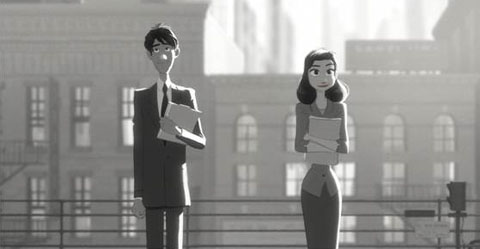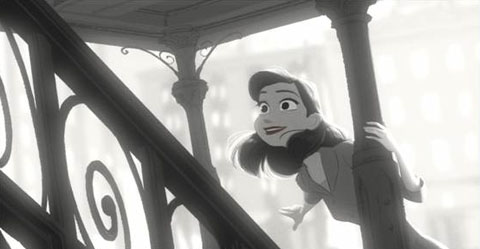

Exclusive: “Paperman” Interview with Director John Kahrs
Seems like everyone is talking about Paperman, the new Disney short that recently premiered at the Annecy Animation Festival and is scheduled to be released with Wreck-It Ralph on November 2nd. I’ve seen the film and will join in with the chorus praising it for its innovative look, its touching story and its refreshing new take on Disney character animation. It’s a breath of fresh air–and one can only hope it portends good things for hand-drawn animators–and its enthusiasts.
Paperman pioneers a new technique that seamlessly merges computer-generated and hand-drawn animation. I recently spoke with director John Kahrs (formerly of Blue Sky, Pixar and since 2007, a supervising animator at Disney Feature, primarily on Tangled) about the production.
Cartoon Brew: How did Paperman get started? Is this part of the Disney Shorts Program?
John Kahrs: After Tangled ended, they had a gap between the ending of that film and the beginning of production on Wreck-It Ralph. Management was wondering: “Is there anything around to push the technology? Anything that we have that’s going to fill the space between films, to utilize as much of the crew as possible? I had ideas about maybe doing a bit of animation that involved 2D and 3D together. So I just pitched it and they were like: “Ok, let’s try this.” But they didn’t really know how far we were going to take it technologically.
Cartoon Brew: Did John [Lasseter] know how the film was going to look – that it would be in black and white? And what inspired the story?
John Kahrs: John didn’t really know what we were doing until I showed him the test—that finally got him on board with the technique and the technology. The idea for the story has been in my head since I lived in New York, when I was first starting out in my career. I was commuting through Grand Central Station, I was in my mid twenties and feeling like I should be enjoying living in the city much more than I actually was—and I couldn’t figure out why I wasn’t. New York is a pretty intimidating place; people have their guard up. It’s odd to feel alone while being surrounded by people all the time. Sometimes you can make random connections with strangers, and I started thinking about that idea. What if someone made a connection? What if this guy made a connection with a girl and he lost her, and he spent the rest of the story trying to get her back? You know, if they were really meant for each other… it’s fate. It’s romantic.
Cartoon Brew: I always like to ask this question: how long did it take from when you basically got a go-ahead, till it being finished. How long was that, about a year?
John Kahrs: Yeah, about a year. Maybe 14 months.
Cartoon Brew: So tell me about this new technique used on the film… how did it come about?
John Kahrs: It really came out of working so much with Glen on Tangled. Seeing all that drawing, being at Disney, being surrounded by that legacy. How exciting, and how much punch there is in the drawn line, how expressive it can be. And how hard the CG guys have to work to try to match that charm. I thought, Why do we have to leave these drawings behind? Why can’t we bring them back up to the front of the image again? Is there a way that CG can kinda carry along the hand drawn line in a way that we haven’t done before?
Ultimately, the problem was solved in a much more sophisticated way than I ever expected by teaming with Eric Daniels first, then Brian Whited who is a young guy and a world class programmer. He developed this program called Meander, a vector based drawing tool that gives the artist a lot of power to manipulate the line after you draw it. We discovered that he was programming this thing and building this software – and we just totally took it over, hijacked him and his program and got him on the project. It’s not like a texture map. It’s just like painting on the surface of the CG. It actually moves on a 2d layer that’s driven by the CG. And the greatest thing about the tool is that all of that drawing is right up front with the hand drawn animator; right there in their space so they can see what they’re doing. They don’t have to send it off on some blackbox that processes it and then it comes back. It stays right in front of them and they can see everything that they’re doing.
One of the things I’m most proud of about is that it really celebrates the line. I mean it’s right there on the forefront of the image. It kind of reminds me a little bit of a little of what Milt Kahl, on 101 Dalmatians, was pushing for with the Xerox line. He didn’t want his line to be sanded away. He wanted that original energy and the speed of his stroke and the expressiveness of the line to be intact. And as much as I loved Tangled—and I feel like we’re in a golden age right now with CG—all the studios today are competing with a stylized form of realism. I have to believe that’s not the only way that animation can look. I feel like 2D needs to come into the place where it can compete with a big blockbuster movie that has tons of CG and so forth. We have to push the processes and techniques and see where we can take them.

Cartoon Brew: There’s nothing today that looks like the original line drawings of an animator…
John Kahrs: When you see the pencil test version of Beauty and the Beast it’s so alive. It’s just magical. There’s some Mark Henn sketch, just two or three lines that make’s a head, and it can be totally alive and full of emotion – and you get that stuff so easily with the group of talent in the building here. In Paperman, we didn’t have a cloth department and we didn’t have a hair department. Here, folds in the fabric, hair silhouettes and the like come from of the commited design decision-making that comes with the 2D drawn process. Our animators can change things, actually erase away the CG underlayer if they want, and change the profile of the arm. And they can design all the fabric in that Milt Kahl kind-of way, if they want to.
Cartoon Brew: The hand of the animator. That’s the thing, unfortunately, missing in some of today’s CG films. Are you developing any other shorts or maybe planning a feature in this style?
John Kahrs: Every time I show the film, the lights come up, and the first question is “Are you working on a feature that looks like this?” I think we are going to move toward that direction – but we’re not quite there yet. I’ve been asked by John and Ed [Catmull] to pursue the technique. Take it to the next level. And I’ll let you guess what the next level is.

.png)